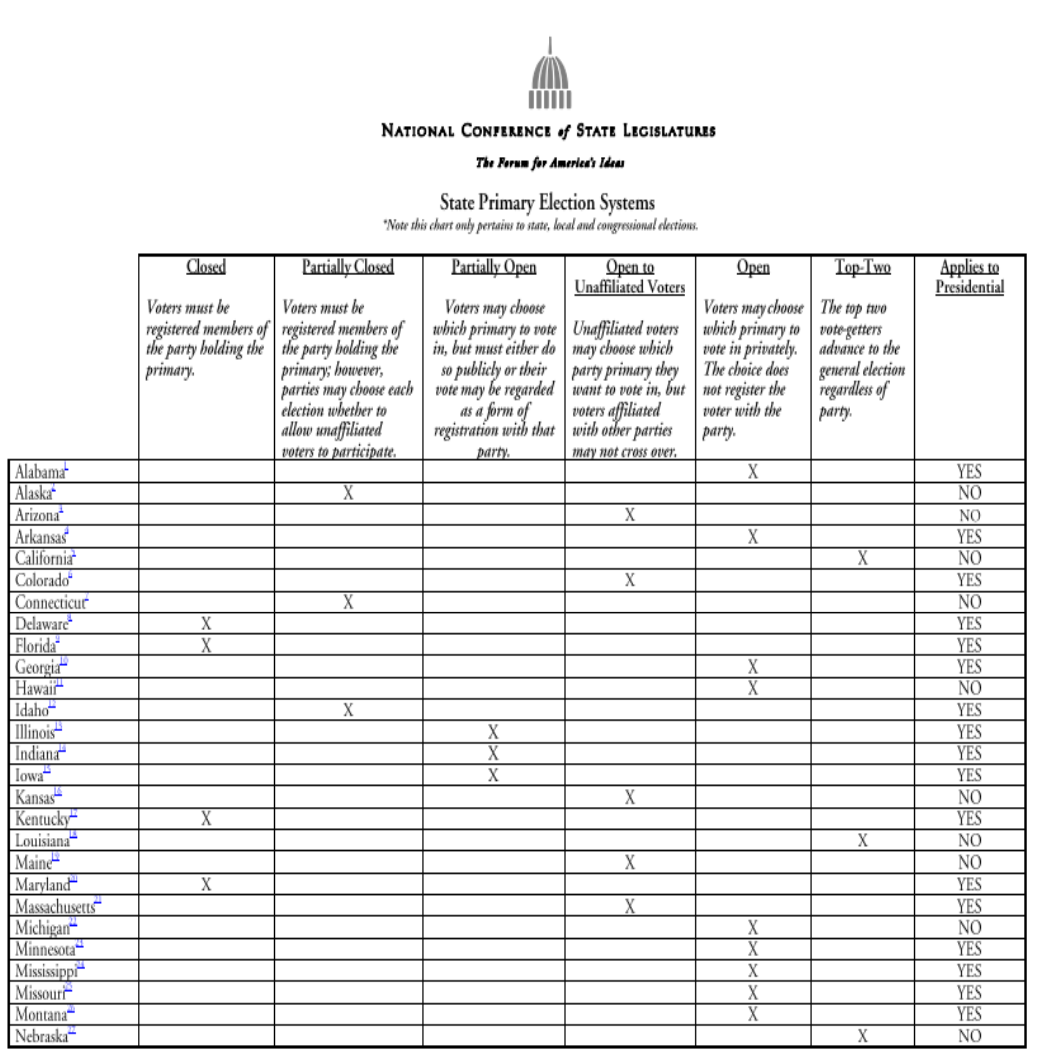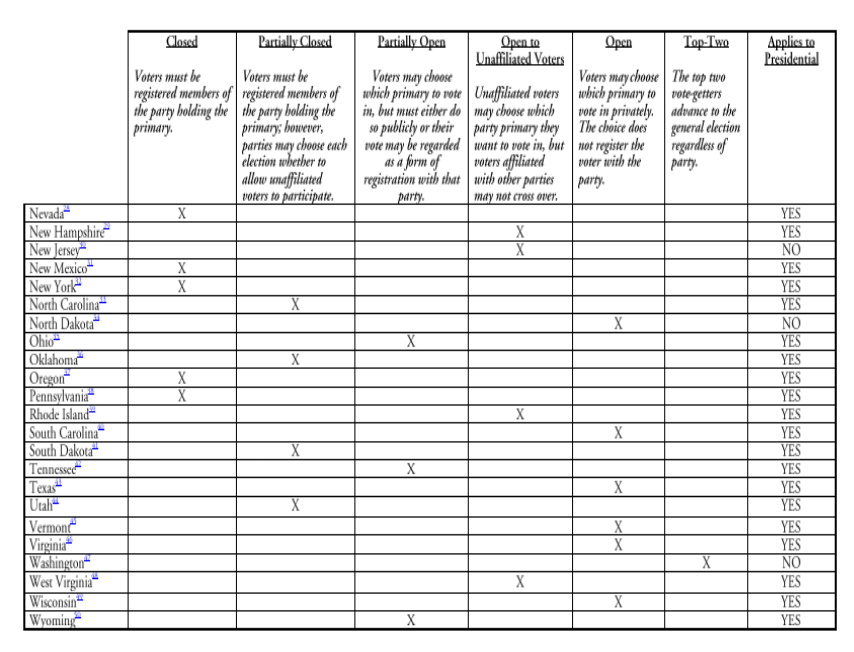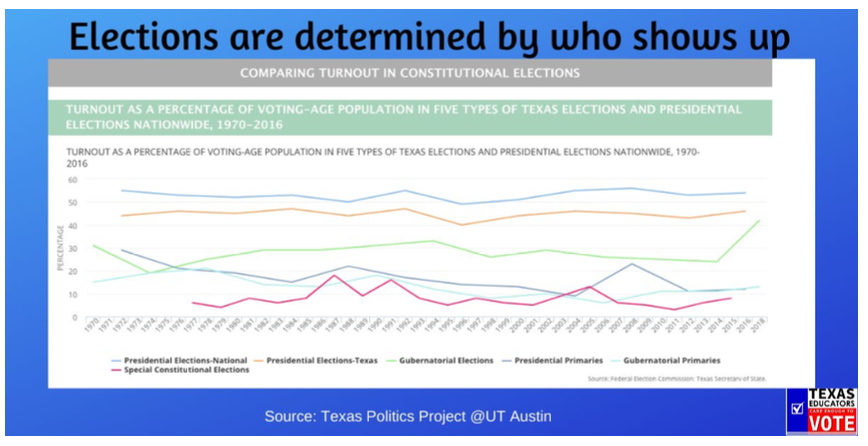5.6: Types of Elections
- Page ID
- 129162
Elections play an essential part in American democracy They offer American voters the opportunity to participate in their government with little investment of time or personal effort. Yet voters should make decisions carefully. Elections are very important because the outcomes of government actions are almost always the result of the people who hold elected office and elections determine which policies we will have to live by. Texas uses four types of elections: primary elections; runoff elections; general elections; and special elections.
Primary Elections
State law, not federal, regulates most aspects of general and local, also called municipal, elections (county, city, and township), as well as primary elections, and are predominantly responsible for administering them. Primary elections are used either to determine the nominees for political parties in advance of a general election or to narrow the field of candidates for a given elective office. Each state decides how it will run primary elections. In Texas, primary elections are held on the second Tuesday in March on even-numbered years. There are several ways that primary elections are organized: closed; semi-closed; open; semi-open: and top-two vote getters (Table 5.2).


Table 5.2 State Primary Election Systems
In a closed primary, only registered members of that political party can participate (vote). Therefore, in a Democratic primary only registered members of the Democratic Party can vote, and in a Republican primary, only registered members of the Republican Party can
vote. So, what happens if you are not registered with either party, a situation described as unaffiliated or independent? Well, then, you are left out and cannot vote in a closed primary election! There are nine states that have closed primaries, including Delaware, Florida, Kentucky, Maryland, Nevada, New Mexico, New York, Pennsylvania, and Oregon. Among states, the closed primary is the second most common type of primary.
Another type of primary is called a partially closed or semi-closed primary. As in closed primaries, registered party members can vote only in their own party’s primary. Semi-closed
primaries, however, allow unaffiliated (independent) voters to participate as well. Depending on the state, Independents either make their choice of party primary privately, inside the voting booth, or publicly, by registering with any party on election day. There are seven states that have semi-closed primaries, including Alaska, Connecticut, Idaho, North Carolina, Oklahoma, South Dakota, and Utah.
The open primary is the most common type of primary. In an open primary election, any registered voter can participate regardless of party affiliation with the caveat that voters can vote in only one party’s primary during a single primary period. Voters in open primary states may be given ballots from both parties, but they may mark only one of them. What this means is that if you are a registered Republican, but you want to vote in the Democratic primary, you can, but then you cannot vote in the Republican primary election. This does not mean that you must then still vote Democratic in the general election just because you voted in the Democratic primary. In an open primary system, all registered voters can participate, even independent voters! Texas is one of fifteen states that has open primaries. Alabama, Arkansas, Georgia, Hawaii, Michigan, Minnesota, Mississippi, Missouri, Montana, North Dakota, South Carolina, Texas, Vermont, Virginia, and Wisconsin all have open primaries.
A variation of the open primary is called the partially open of semi-open primary. The most significant difference between a semi-open primary and open primary system is the use of a party-specific ballot. In a semi-open primary, a public declaration in front of the election judge is made and a party-specific ballot given to the voter. Certain states that use the open-primary format may print a single ballot and the voter must choose on the ballot itself which political party’s candidates they will select. There are six states that have semi-open primaries. These include Illinois, Indiana, Iowa, Ohio, Tennessee, and Wyoming.
Runoff Elections
Winning the primary election requires an absolute majority in Texas, meaning that the party's nominees must have more votes than all opponents combined—fifty percent plus one vote. When you have three or more candidates running in the primary, it is unlikely that any candidate will receive an absolute majority of votes. If no candidate receives an absolute majority, there is a runoff election between the top two vote-getters.
Voter turnout in these elections can be very low, often in the single digits. Texas has low voter participation especially in primary elections. As reported in the Texas Tribune, “with 16.2 million Texans registered to vote, just 25.2 percent cast a ballot in the primary election,” and that was the presidential primary. Turnout for gubernatorial primaries in Texas historically is much lower with only 11.6 percent turnout in the 2014 gubernatorial primary here in Texas. Only an average of 8.5 percent of eligible Texans vote in the Constitutional elections (Figure 5.22).
Do you still think your vote doesn’t matter?

General Elections
A general election is an election in which voters cast ballots to select public officials at any level, including city, county, state, or country. General elections determine the final winner—the candidate to take office. Usually, the candidate obtaining a plurality, that is, the most votes wins (even if not necessarily an absolute majority of votes, such as when three or more candidates run for a particular office). At the presidential level, states determine the winner through their electors, or representatives, in the electoral college. Electors cast votes from their respective states to determine the president and as has been the case in a number of national elections the winner had not received the popular vote, that is, the majority of votes cast nationally.
Major state officials, such as the governor, lieutenant governor, attorney general, and comptroller of public accounts, are elected in midterm elections, that is elections that occur in nonpresidential election years. Previously Texans had the option of straight-ticket voting. This meant that voters could check a box at the top of the ballot marking votes for candidates from a single party, all Republicans or all Democrats. Not all states have this option. In fact, Texas has been one of only nine states to have straight-ticket voting. Since September 2020, however, Governor Greg Abbott has banned straight-ticket voting, arguing the ban forces voters to make more informed choices.42 Critics of this decision argue that Republicans stand to gain more because in the past straight-ticket voting was employed more by Democrats.43 The populous counties that voted straight ticket for Democrats in the 2016 presidential elections include Dallas, Bexar, Hidalgo, Travis, Harris, and El Paso.44 More Republicans employed straight-ticket voting in Collin, Fort Bend, and Denton.45
Special Elections
Special elections are used to ratify or reject Texas constitutional amendments, fill elected offices that have become vacant between general elections, provide approval to borrow money, or other non-recurring issues. In most cases, special elections occur after the incumbent—the current holder of a political office—dies or resigns, but they also occur when the incumbent becomes ineligible to continue in office. Governor Greg Abbott called a thirty-day special session in August 2020 to replace Republican senator Pat Fallon for the Texas Senate. Fallon resigned his position after being nominated for U.S. Congress and winning the seat handily in the heavily Republican district of rural North Texas. As with primary elections, general elections also require fifty percent plus one, an absolute majority, to win. In the six-candidate race to replace Fallon, no one candidate was able to secure enough votes to have the absolute majority required to win. Shelly Luther, who held a narrow lead of 164 votes46, and State Representative Drew Springer of Muenster advanced to the runoffs. What made this election interesting is that Luther, who is not a politician and has repeatedly criticized Governor Abbott’s handling of the COVID pandemic, had gained national attention after being jailed for reopening her hair salon in Dallas despite mandatory closures. The close race between the two Republicans indicated many Texans agreed with Luther’s position and signaled ruptures within the Republican base.47 Springer ultimately won in the runoff election with 56.5 percent of the vote.48
42. Jolie McCullough, “Gov. Abbott Signs Bill to Eliminate Straight-Ticket Voting Beginning in 2020,” Texas Tribune, June 1, 2017, https://www.texastribune.org/2017/06...ill-eliminate- straight-ticket-voting/.
43. McCullough, “Straight-Ticket Voting,” https://www.texastribune.org/2017/06...ticket-voting/.
44. McCullough, “Straight-Ticket Voting,” https://www.texastribune.org/2017/06...ticket-voting/.
45. McCullough, “Straight-Ticket Voting,” https://www.texastribune.org/2017/06...ticket-voting/.
46. Patrick Svitek, “Special Election Runoff between Shelley Luther and State Rep. Drew Springer Set for Dec. 19,” Texas Tribune, Oct. 10, 2020, https://www.texastribune.org/2020/10...drew-springer/.
47. Asher Price, “Texas Senate Runoff Shapes Up as Battle for the Future of Texas Republican Party,” Austin American-Statesman, Dec. 11, 2020, https://www.statesman.com/story/news...xy/3896349001/.
48. Eleanor Dearman, “Drew Springer Wins Texas Senate District 30 Seat Over Shelley Luther,” Fort Worth Star-Telegram, Dec. 19, 2020, https://www.star-telegram.com/news/p...t/article24795.

